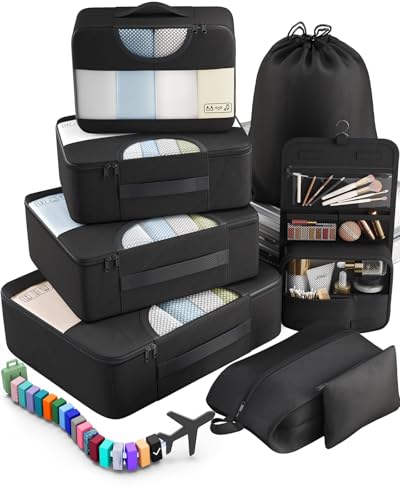In the Cook Islands, they use Type I power plugs and outlets. The voltage is 240V, and the frequency is 50Hz.
So, you’ll need a travel adapter in the Cook Islands. Their plugs and outlets are different from the Type A and B ones we use back in the States.
Quick Overview of the Plugs in the Cook Islands:
- Plug type in the Cook Islands: I
- Standard voltage: 240V
- Frequency: 50Hz
- Need a travel adapter? Yes, you do need a travel adapter
- Need a voltage converter? Likely needed for a few devices
- Recommended plug adapter: Vintar Universal Travel Adapter Kit
This page combines official data from local electricity agencies, international IEC standards, and firsthand experiences shared by travelers who recently visited these countries.
The Only Travel Adapter You’ll Need in the Cook Islands
Need a travel adapter for the Cook Islands? We don’t sell them, but we’ve done the research to find the best one—covering voltage, outlet types, and safety. Here’s the one we recommend:
Recommended Travel Plug Adapter
by 1,000+ travelers on Amazon
If you’re already abroad and forgot your power adapter, don’t stress. You can usually get by just fine. But having one with you from the beginning adds a little peace of mind—and makes settling in that much easier.
Travelers to the Cook Islands often continue to New Zealand, French Polynesia, or Samoa. Be sure to check which plug you’ll need.
Power Outlets in the Cook Islands
In the Cook Islands, they use Type I power plugs and outlets.
Type I

Type I outlets have two flat prongs in a V-shape with a grounding pin and accept both grounded and ungrounded Type I plugs; some ungrounded Type A plugs may fit with an adapter, but grounding will be lost.
Do You Need a Voltage Converter?
In the Cook Islands, the power supply operates on a different voltage than the U.S. standard of 120V, so a voltage converter is likely required for your devices to work properly.
Always check your device’s power label before traveling. If it says “100-240V, 50/60 Hz”, your device can handle different voltages worldwide without needing a converter. This applies to most laptops, tablets, cameras, phones, and rechargeable personal care devices.

Which Travel Devices May Need a Converter?
Don’t want to guess which converter works? Here are the best-reviewed ones worth checking out.
| Device | Need Converter? | Notes |
|---|---|---|
| Phone | ❌ No (usually) | Most modern phone chargers are dual voltage (100–240V) |
| Laptop | ❌ No (usually) | Check the power brick label for 100–240V |
| Hairdryer | ✅ Yes (often) | High wattage; many models are not dual voltage |
| Electric toothbrush | ⚠️ Check voltage | Some models are 110V only |
| Camera / DSLR | ❌ No (usually) | Most chargers are dual voltage |
| Power bank | ❌ No | Charges via USB, adapter is enough |
| Electric shaver / trimmer | ⚠️ Check voltage | Older or cheaper models may not support 230V |
| Tablet / iPad | ❌ No | All models are dual voltage |
| Portable fan | ✅ Yes (sometimes) | Many models are not compatible with 230V |
| Game console | ⚠️ Check voltage | Newer consoles like PS5 and Xbox are often dual voltage — check to be sure |
| Bluetooth speaker | ❌ No (usually) | Charges via USB |
| E-reader (Kindle, etc.) | ❌ No | USB charging only, no converter needed |
Top Travel Essentials to Pack
A good travel experience comes down to the small things. These smart additions can help you avoid last-minute stress and keep your trip on track.
Digital Luggage Scale
Packing Cubes
Power Bank
More About the Cook Islands
The Cook Islands is a collection of fifteen islands, with 2024 visitor arrivals expected to rival the 2019 record of about 171,500 international tourists. Tourism contributes roughly 70 % of GDP, so the islands’ economy leans heavily on it. Around 7 % of visitors come from North America, and the rest mostly from New Zealand and Australia. Major activity centers on Rarotonga and Aitutaki, but low-key is the norm everywhere.
The islands dazzle with reef-lined lagoons, overwater bungalows, and cultural dance nights featuring vibrant island music and costumes. On Rarotonga, a 17-mile round-the-island road loops past beaches, markets, and cafés offering local seafood. Aitutaki offers one of the world’s most photographed lagoons and perfect snorkeling. Knowing a few Māori words can go a long way, and effort to connect culturally is always rewarded.
For U.S. travelers, the Cook Islands offer U.S.-style ease with island charm. English is universal, the main airport handles international traffic from Auckland and Los Angeles via Fiji, and services cater to visitors. Activities range from reef excursions, paddle-boarding, vanilla farm tours, to tuk-tuk rides through tropical roads. It’s casual, sun-soaked, and full of community-driven hospitality in a polished Pacific setting.
The Cook Islands uses the same plugs and outlets as Australia.




